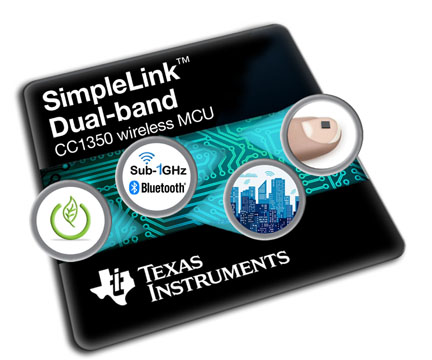By Jim Harrison
The CC1350 low-power wireless MCU is capable of handling both sub-1 GHz and 2.4 GHz RF frequencies. The device combines a flexible, low-power RF transceiver with a 48-MHz Cortex-M3 processor in a platform supporting multiple physical layers and RF standards. This combination of communications yields very long range together with a Bluetooth low-energy smartphone connection that enables great user experience. The chip has a dedicated radio controller (a Cortex-M0) that handles low-level RF protocol commands that are stored in ROM or RAM, thus ensuring ultra-low power and flexibility and updatability.
The IC offers a range of up to 20 km on a coin-cell battery for building and factory automation, alarm and security, smart grid, asset tracking, and wireless sensor network applications. Dual-band connectivity expands the functionality of a sub-1 GHz network with Bluetooth low-energy implementations such as beaconing, over-the-air updates, smart commissioning, and remote displays.

Targeting low-power wide area networks (LPWAN), the transceiver in the CC1350 can operate in the 315-, 433-, 470-, 500-, 779-, 868-, 915-, and 920-MHz bands and the 2.4-GHz ISM band. The IC is available in a 7 x 7-mm QFN package, and will also come in 4 x 4-, 5 x 5-mm versions. It uses a Cortex M3 processing core with 128 Kbytes of flash and has a sleep current of 0.7 uA, which allows for as much as 10 years of battery life. It uses a supply voltage of 1.8 to 3.8 V. In Rx the chip takes 5.4 mA in sub-1 GHz mode, or 6.4 mA in Bluetooth LE 2.4 GHz Rx operation. Supply current in transmit at +10 dBm is 13.4 mA for sub-1 GHz operation and 22.3 mA at +9 dBm using Bluetooth LE and 2.4-GHz modes.
The IC also offers excellent receiver sensitivity of −124 dBm using long-range mode, −110 dBm at 50 kbits/s (sub-1 GHz), and −87 dBm at Bluetooth LE. Selectivity (±100 kHz) is 56 dB and blocking performance (±10 MHz) is 90 dB. It has an RTC, an 8-channel 12-bit A/D converter, an AES-128 security module, a true random number generator, support for eight capacitive sensing buttons, and a temperature sensor. The LAUNCHXL-CC1350 LaunchPad development kit is available for only $29. The CC1350F128RGZR IC costs $4.60 ea/1,000.
Advertisement
Learn more about Texas Instruments





